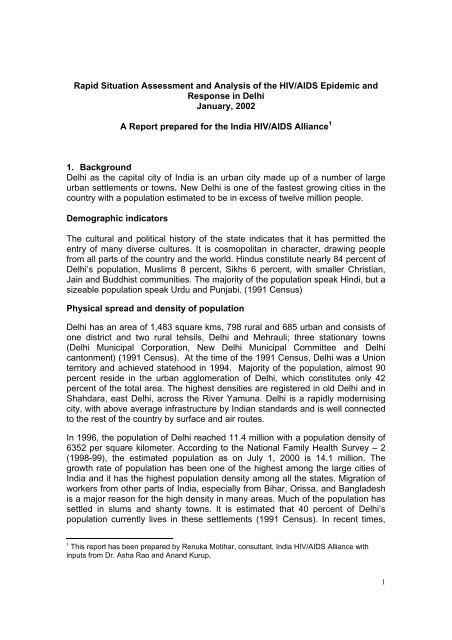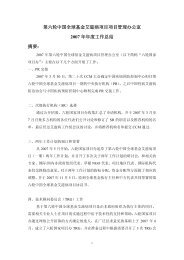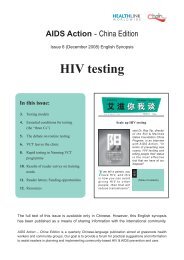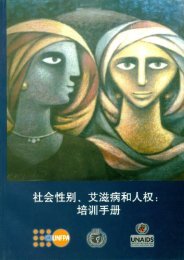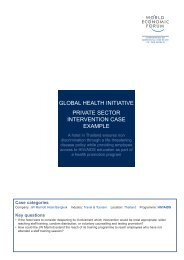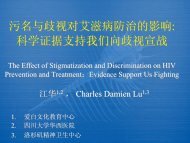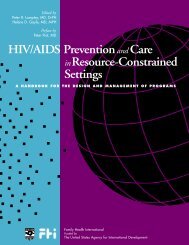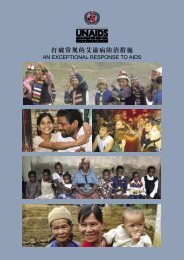Rapid Situation Assessment and Analysis of the HIV/AIDS Epidemic ...
Rapid Situation Assessment and Analysis of the HIV/AIDS Epidemic ...
Rapid Situation Assessment and Analysis of the HIV/AIDS Epidemic ...
Create successful ePaper yourself
Turn your PDF publications into a flip-book with our unique Google optimized e-Paper software.
<strong>Rapid</strong> <strong>Situation</strong> <strong>Assessment</strong> <strong>and</strong> <strong>Analysis</strong> <strong>of</strong> <strong>the</strong> <strong>HIV</strong>/<strong>AIDS</strong> <strong>Epidemic</strong> <strong>and</strong><br />
Response in Delhi<br />
January, 2002<br />
A Report prepared for <strong>the</strong> India <strong>HIV</strong>/<strong>AIDS</strong> Alliance 1<br />
1. Background<br />
Delhi as <strong>the</strong> capital city <strong>of</strong> India is an urban city made up <strong>of</strong> a number <strong>of</strong> large<br />
urban settlements or towns. New Delhi is one <strong>of</strong> <strong>the</strong> fastest growing cities in <strong>the</strong><br />
country with a population estimated to be in excess <strong>of</strong> twelve million people.<br />
Demographic indicators<br />
The cultural <strong>and</strong> political history <strong>of</strong> <strong>the</strong> state indicates that it has permitted <strong>the</strong><br />
entry <strong>of</strong> many diverse cultures. It is cosmopolitan in character, drawing people<br />
from all parts <strong>of</strong> <strong>the</strong> country <strong>and</strong> <strong>the</strong> world. Hindus constitute nearly 84 percent <strong>of</strong><br />
Delhi’s population, Muslims 8 percent, Sikhs 6 percent, with smaller Christian,<br />
Jain <strong>and</strong> Buddhist communities. The majority <strong>of</strong> <strong>the</strong> population speak Hindi, but a<br />
sizeable population speak Urdu <strong>and</strong> Punjabi. (1991 Census)<br />
Physical spread <strong>and</strong> density <strong>of</strong> population<br />
Delhi has an area <strong>of</strong> 1,483 square kms, 798 rural <strong>and</strong> 685 urban <strong>and</strong> consists <strong>of</strong><br />
one district <strong>and</strong> two rural tehsils, Delhi <strong>and</strong> Mehrauli; three stationary towns<br />
(Delhi Municipal Corporation, New Delhi Municipal Committee <strong>and</strong> Delhi<br />
cantonment) (1991 Census). At <strong>the</strong> time <strong>of</strong> <strong>the</strong> 1991 Census, Delhi was a Union<br />
territory <strong>and</strong> achieved statehood in 1994. Majority <strong>of</strong> <strong>the</strong> population, almost 90<br />
percent reside in <strong>the</strong> urban agglomeration <strong>of</strong> Delhi, which constitutes only 42<br />
percent <strong>of</strong> <strong>the</strong> total area. The highest densities are registered in old Delhi <strong>and</strong> in<br />
Shahdara, east Delhi, across <strong>the</strong> River Yamuna. Delhi is a rapidly modernising<br />
city, with above average infrastructure by Indian st<strong>and</strong>ards <strong>and</strong> is well connected<br />
to <strong>the</strong> rest <strong>of</strong> <strong>the</strong> country by surface <strong>and</strong> air routes.<br />
In 1996, <strong>the</strong> population <strong>of</strong> Delhi reached 11.4 million with a population density <strong>of</strong><br />
6352 per square kilometer. According to <strong>the</strong> National Family Health Survey – 2<br />
(1998-99), <strong>the</strong> estimated population as on July 1, 2000 is 14.1 million. The<br />
growth rate <strong>of</strong> population has been one <strong>of</strong> <strong>the</strong> highest among <strong>the</strong> large cities <strong>of</strong><br />
India <strong>and</strong> it has <strong>the</strong> highest population density among all <strong>the</strong> states. Migration <strong>of</strong><br />
workers from o<strong>the</strong>r parts <strong>of</strong> India, especially from Bihar, Orissa, <strong>and</strong> Bangladesh<br />
is a major reason for <strong>the</strong> high density in many areas. Much <strong>of</strong> <strong>the</strong> population has<br />
settled in slums <strong>and</strong> shanty towns. It is estimated that 40 percent <strong>of</strong> Delhi’s<br />
population currently lives in <strong>the</strong>se settlements (1991 Census). In recent times,<br />
1 This report has been prepared by Renuka Motihar, consultant, India <strong>HIV</strong>/<strong>AIDS</strong> Alliance with<br />
inputs from Dr. Asha Rao <strong>and</strong> An<strong>and</strong> Kurup.<br />
1
ural regions <strong>of</strong> Delhi have had to absorb a large number <strong>of</strong> migrants, who have<br />
ei<strong>the</strong>r come directly to settle in <strong>the</strong>se parts or have moved from <strong>the</strong> Delhi urban<br />
agglomeration due to congestion. The sex ratio <strong>of</strong> <strong>the</strong> total population <strong>of</strong> Delhi<br />
Union territory was 827 females per thous<strong>and</strong> males, with a lower ratio in <strong>the</strong><br />
rural (807) as compared to <strong>the</strong> urban (830) areas (1991 Census). This represents<br />
a differential pattern <strong>of</strong> growth with a marked imbalance in <strong>the</strong> sex ratio, in part a<br />
consequence <strong>of</strong> migration patterns <strong>and</strong> in part representing <strong>the</strong> lower status <strong>of</strong><br />
women.<br />
Table 1: Demographic Indicators in Delhi<br />
Population (million), NFHS-2 14.1<br />
% urban, 1991 89.9<br />
Density (pop/sq.km.), 1996 6352<br />
% Schedule caste, 1991 19.05<br />
% Hindu 78.8<br />
% Muslim 8.9<br />
% Sikh 4.6<br />
Rural (per 1000)<br />
Birth rate<br />
Death rate<br />
Urban (per 1000)<br />
Birth rate<br />
Death rate<br />
24.9<br />
4.9<br />
23.2<br />
6.1<br />
Natural Growth rate, rural (%) 20<br />
Natural growth rate, urban (%) 17.1<br />
Slum population, as % total urban population, 1991 41<br />
% Literate, 2001 87.37% - males<br />
75% - females<br />
% Labour force participation rate (2001) 54.3 - males<br />
10.2 - females<br />
Sex ratio, 2001<br />
821 females per<br />
1000 males<br />
Source: Census 1991, Census 2001, NFHS-2 (1998-99)<br />
2
A survey carried out by several NGOs including Bachpan Bachao Andolan,<br />
Navjyoti Foundation <strong>and</strong> Prayas under <strong>the</strong> banner <strong>of</strong> Ashray Adhikar Abhiyan<br />
(AAA), found that <strong>the</strong>re are 53,000 homeless people in Delhi living <strong>of</strong>f <strong>the</strong><br />
streets. 2 The largest number <strong>of</strong> homeless people was in <strong>the</strong> walled city area <strong>of</strong><br />
Old Delhi. Here <strong>the</strong> pavements, were home to 15,000 people, though, un<strong>of</strong>ficially,<br />
<strong>the</strong> figure is believed to be 1,00,000. Most <strong>of</strong> <strong>the</strong> people live on <strong>the</strong> roadsides, at<br />
ab<strong>and</strong>oned bus stops, under unused bridges, railway platforms, deserted lanes,<br />
in parks <strong>and</strong> under flyovers. These people are not represented by any<br />
government Census exercise.<br />
Table 2. Health Indicators<br />
Total Fertility rate 2.40<br />
Infant Mortality rate 46.8 per 1000<br />
Maternal Mortality rate 3.2 per 1000<br />
Women aged 15-49 who have ever<br />
heard <strong>of</strong> <strong>AIDS</strong><br />
Contraceptive prevalence rate among<br />
married women<br />
Source: NFHS-2, 1998-99<br />
79.2 %<br />
63.8%<br />
2. <strong>HIV</strong>/<strong>AIDS</strong> <strong>Epidemic</strong><br />
The National <strong>AIDS</strong> Control Organisation (NACO) describes Delhi as a low<br />
affected state (<strong>HIV</strong> prevalence in any <strong>of</strong> <strong>the</strong> high risk groups is still less than 5<br />
percent <strong>and</strong> is less than 1 percent among antenatal women) (NACO, 2000-2001).<br />
Most authorities agree that because <strong>of</strong> under-developed epidemiological systems,<br />
surveillance in India is challenging <strong>and</strong> AIDs cases are under-reported in India.<br />
State Number <strong>of</strong> Sites <strong>HIV</strong> Prevalence %<br />
Delhi STD 3<br />
ANC 3<br />
IVDU 1<br />
3.26<br />
0.25<br />
5.00<br />
2 Dorabjee et al. <strong>Rapid</strong> <strong>Situation</strong> <strong>Assessment</strong> <strong>of</strong> Drug Use in Delhi, Sharan, New Delhi.<br />
3
NACO Behaviour Surveillance Survey for Delhi, 2001<br />
Awareness <strong>of</strong> <strong>HIV</strong>/<strong>AIDS</strong><br />
Male Female Total<br />
Ever heard <strong>of</strong><br />
<strong>HIV</strong>/<strong>AIDS</strong><br />
Transmission<br />
through sexual<br />
route<br />
Transmission<br />
through blood<br />
transfusion<br />
Transmission<br />
through needlesharing<br />
90.6 85.9 88.2<br />
88.1 82.1 85.0<br />
89.5 82.7 86.0<br />
88.1 80.7 84.3<br />
Awareness <strong>of</strong> Sexually Transmitted Diseases (STDs)<br />
Male Female Total<br />
Linkage between<br />
STD <strong>and</strong><br />
<strong>HIV</strong>/<strong>AIDS</strong><br />
28.1 19.9 23.9<br />
STD Symptoms<br />
among women<br />
32.7 32.1 32.4<br />
STD symptoms<br />
among men<br />
33.1 35.4 34.3<br />
4
STD Prevalence <strong>and</strong> Treatment Seeking Behaviour<br />
Male Female Total<br />
Treatment in Govt.<br />
Hospital/Clinic<br />
during last<br />
episode<br />
21.3 9.6 13.7<br />
Aware <strong>of</strong><br />
someone infected<br />
with <strong>HIV</strong>/<strong>AIDS</strong><br />
2.3 2.0 2.2<br />
Aware <strong>of</strong><br />
someone who has<br />
died <strong>of</strong> <strong>HIV</strong>/<strong>AIDS</strong><br />
1.8 2.2 2.0<br />
Aware <strong>of</strong> <strong>HIV</strong><br />
testing facility in<br />
<strong>the</strong> area<br />
21.1 14.9 17.9<br />
Report on Sentinel Surveillance for <strong>HIV</strong> Infection<br />
No.<br />
<strong>of</strong><br />
sites<br />
1999 2000 2001<br />
No.<br />
<strong>of</strong><br />
<strong>HIV</strong><br />
+ve<br />
cases<br />
<strong>HIV</strong><br />
+ve<br />
%<br />
No.<br />
<strong>of</strong><br />
sites<br />
No.<br />
<strong>of</strong><br />
<strong>HIV</strong><br />
+ve<br />
cases<br />
<strong>HIV</strong><br />
+ve<br />
%<br />
No.<br />
<strong>of</strong><br />
sites<br />
No.<br />
<strong>of</strong><br />
<strong>HIV</strong><br />
+ve<br />
cases<br />
<strong>HIV</strong><br />
+ve<br />
%<br />
STDs 1 2 0.8 3 11 3.04 4 41 5.35<br />
IDUs - - - 1 5 5.0 1 4 2.39<br />
ANC 2 2 0.25 3 2 0.16 4 2 0.12<br />
According to <strong>the</strong> Ministry <strong>of</strong> Health, <strong>the</strong>re are 646 cases <strong>of</strong> <strong>AIDS</strong> reported in <strong>the</strong><br />
city so far. While 167 patients have died, <strong>the</strong>re are over 22,000 <strong>HIV</strong> positive<br />
cases in Delhi. Out <strong>of</strong> <strong>the</strong> total 646 cases, 557 were male, 89 female, 18 in <strong>the</strong><br />
5
age group <strong>of</strong> 0-14 years, 234 in <strong>the</strong> 15-29 years, 282 in <strong>the</strong> 30-49 years, 66<br />
above 50 years <strong>and</strong> 46 have not specified <strong>the</strong>ir age. The sentinel surveillance<br />
survey was conducted at seven sites in <strong>the</strong> city in 2000 which revealed that in<br />
general 25 per cent <strong>of</strong> <strong>the</strong> population were <strong>HIV</strong> positive, among STD patients,<br />
3.73 percent were infected <strong>and</strong> among drug users it was five per cent. According<br />
to <strong>the</strong>ir statistics, 73.58 percent people had been infected due to unsafe sex,<br />
5.18 percent due to transfusion <strong>of</strong> infected blood, 4.08 percent due to injectable<br />
drug use, 1.72 percent due to prenatal transmission <strong>and</strong> 15.40 percent due to<br />
o<strong>the</strong>r reasons. 3 According to <strong>the</strong> ministry, some <strong>of</strong> <strong>the</strong> reasons that have<br />
contributed to <strong>the</strong> high risk <strong>of</strong> <strong>HIV</strong> transmission are increase in migrant<br />
population, street children, commercial sex workers, <strong>and</strong> intravenous drug users<br />
in <strong>the</strong> city.<br />
People living with <strong>HIV</strong> <strong>and</strong> people suspected <strong>of</strong> being <strong>HIV</strong> positive still face<br />
severe stigma <strong>and</strong> discrimination from <strong>the</strong> medical community. There are reports<br />
<strong>of</strong> people having been denied care <strong>and</strong> complete lack <strong>of</strong> confidentiality.<br />
Evidence from Epidemiological <strong>and</strong> Clinic Studies<br />
BBC World Service Trust <strong>and</strong> ORG CSR recently conducted a formative<br />
research <strong>and</strong> baseline survey under <strong>the</strong>ir project “Promoting <strong>HIV</strong>/<strong>AIDS</strong><br />
Behavioural Change in low prevalence states <strong>of</strong> North India – Uttar Pradesh,<br />
Rajasthan <strong>and</strong> Delhi”. 4 The research explored issues <strong>of</strong> interpersonal<br />
communication regarding sexual matters; knowledge, attitudes <strong>and</strong> perceptions<br />
on <strong>HIV</strong>/<strong>AIDS</strong> <strong>and</strong> STIs <strong>and</strong> finally, sexual relationships <strong>and</strong> behaviours in <strong>the</strong><br />
community.<br />
According to <strong>the</strong>ir findings, adolescent girls were hesitant to share concerns on<br />
sexual issues, after repeated probing <strong>the</strong>y identified multiple sexual relationships<br />
as a major mode <strong>of</strong> transmission <strong>of</strong> <strong>HIV</strong>/STIs. There was virtually non-existent<br />
self-perception <strong>of</strong> risk. Adolescent boys knew more about <strong>HIV</strong>/<strong>AIDS</strong> than girls.<br />
However, <strong>the</strong>y could not distinguish between myths <strong>and</strong> correct information. The<br />
self- perception <strong>of</strong> risk was high but only in comparison to o<strong>the</strong>r groups. Some <strong>of</strong><br />
<strong>the</strong> participants boasted about multiple relationships. Adult women were not<br />
aware <strong>of</strong> <strong>the</strong> causes <strong>of</strong> <strong>HIV</strong>/<strong>AIDS</strong>, were shy in discussing condom use, had no<br />
discussions on sexual matters with <strong>the</strong> spouse; after repeated probing identified<br />
multiple sexual relationships as <strong>the</strong> most common route <strong>of</strong> transmission <strong>of</strong><br />
<strong>HIV</strong>/<strong>AIDS</strong>. They reported “bro<strong>the</strong>l” visits as resulting in multiple sexual<br />
relationships. Adult men considered <strong>HIV</strong>/<strong>AIDS</strong> to be a western disease. They<br />
were aware about condoms for family planning but did not favour use. They were<br />
unwilling to discuss pre-marital or extra-marital sexual relationships. They<br />
3 “Anti-<strong>AIDS</strong> drive in <strong>the</strong> city in February”, The Asian Age, January 4, 2002, New Delhi<br />
4 “Research Findings (Formative Research <strong>and</strong> Baseline Survey): Promoting <strong>HIV</strong>/<strong>AIDS</strong><br />
Behavioural Change in low prevalent states <strong>of</strong> North India”, BBC World Service Trust <strong>and</strong> ORG<br />
CSR. Presentation, January, 2002<br />
6
accepted that extra <strong>and</strong> pre-marital sexual relationships existed but denied<br />
“personal” knowledge.<br />
In <strong>the</strong> findings on perceptions related to PLHAs, 4 percent respondents reported<br />
knowing anyone who was infected with <strong>HIV</strong>. Respondents most likely to report<br />
this were urban (73 %), men (61%) between 15-29 years <strong>of</strong> age, belonging to<br />
high SES (51%). Around 7 percent respondents knew anyone who had been<br />
died <strong>of</strong> <strong>HIV</strong>/<strong>AIDS</strong>. The respondents most likely to know someone who had died<br />
<strong>of</strong> <strong>AIDS</strong> were more likely to be urban (62%), men (60%), between <strong>the</strong> ages <strong>of</strong> 15-<br />
19 (34%) or 20-29 (40%) <strong>and</strong> belonging to higher SES (53%).<br />
At face value, over 70 percent <strong>of</strong> <strong>the</strong> respondents indicated that <strong>the</strong> people in<br />
<strong>the</strong>ir village/locality would allow <strong>HIV</strong>/<strong>AIDS</strong> patients to stay in <strong>the</strong> village/locality.<br />
However, when asked if <strong>AIDS</strong> patients could be treated along with general<br />
patients less than half (45%) <strong>of</strong> respondents answered in <strong>the</strong> affirmative. When<br />
asked if <strong>AIDS</strong> patients should be kept in isolation, over 50% responded in <strong>the</strong><br />
affirmative. Delhi respondents reported most positive attitudes (53%) <strong>and</strong> U.P.<br />
respondents reported <strong>the</strong> most negative attitudes at 59%. In <strong>the</strong> best case<br />
scenario, only about 50% <strong>of</strong> <strong>the</strong> respondents by state supported positive<br />
attitudes towards PLWHA. Urban respondents had more positive attitudes (61%)<br />
in comparison to rural audiences (40%). However, more women (54%) reported<br />
lack <strong>of</strong> positive attitudes compared to men (32%). Higher age groups <strong>and</strong> lower<br />
SES tend to lower positive attitudes. (Details <strong>of</strong> study in annexure)<br />
Injecting Drug Use <strong>and</strong> <strong>HIV</strong><br />
The sharing <strong>of</strong> injecting equipment among India’s IDU community is widespread<br />
<strong>and</strong> in many circumstances it is considered <strong>the</strong> norm. The recent RSA in India<br />
showed that most IDUs had at some stage (<strong>of</strong>ten within <strong>the</strong> past 6 months)<br />
shared <strong>the</strong>ir needle <strong>and</strong> syringe. The rate <strong>of</strong> ever-sharing in Delhi is 50 percent.<br />
(Sharan, 2001). Estimating <strong>the</strong> number <strong>of</strong> drug users in India has for years<br />
proven elusive <strong>and</strong> this still remains <strong>the</strong> case. A rapid situation assessment (RSA)<br />
<strong>of</strong> injecting in Delhi has shown that <strong>the</strong> estimates <strong>of</strong> IDUs in Delhi is 25,000-<br />
30,000 (Dorabjee <strong>and</strong> Samson, 2000). While examining <strong>the</strong> percentage <strong>of</strong> opiate<br />
users who are current IDUs <strong>the</strong> extent <strong>of</strong> injecting varies from one city to ano<strong>the</strong>r.<br />
The recent RSA data for Delhi shows 27 percent. The majority <strong>of</strong> drug users in<br />
India are male <strong>and</strong> in many drug treatment centers female drug users range from<br />
1 percent to 10 percent depending on <strong>the</strong> city <strong>and</strong> <strong>the</strong> geographic region.<br />
(UN<strong>AIDS</strong> <strong>and</strong> UNDCP, 2000). There is a great stigma attached to women<br />
seeking assistance <strong>and</strong> many cannot go into treatment for long periods <strong>of</strong> time<br />
because <strong>the</strong>y need to look after <strong>the</strong>ir children. A study in Delhi <strong>of</strong> female drug<br />
users (N=35) shows that 30 percent are involved in commercial sex work (CSW).<br />
While 15% <strong>of</strong> <strong>the</strong> respondents admitted to being IDUs, it is not clear if <strong>the</strong>se<br />
same people are also CSW. (Sharan, Dorabjee et al, 2001).<br />
Recent data from <strong>the</strong> RSA study on drug use shows <strong>the</strong> onset <strong>of</strong> drug use in<br />
various cities ranged from 15 to 18 years. Many drug users are from a lower<br />
7
socio-economic background with substantial numbers having poor education <strong>and</strong><br />
working in insecure positions or experiencing high levels <strong>of</strong> unemployment. In<br />
2000, <strong>HIV</strong> infections among IDUs in Delhi was 44.8 percent. Of increasing<br />
concern is <strong>the</strong> transmission <strong>of</strong> <strong>HIV</strong> infection among IDU to <strong>the</strong>ir non-injecting<br />
wives.<br />
Men who have sex with Men (MSM) <strong>and</strong> <strong>HIV</strong><br />
Naz Foundation India is one <strong>of</strong> <strong>the</strong> very few organizations who has been working<br />
with men who have sex with men (MSM) in Delhi <strong>and</strong> had conducted an initial<br />
baseline study <strong>and</strong> recently a mid term survey as a part <strong>of</strong> <strong>the</strong>ir project. The<br />
findings were as follows:<br />
Condom usage Baseline study (%) Mid Term Survey (%)<br />
Never 59% 33%<br />
Sometimes 30.25% 24.25%<br />
All <strong>the</strong> time 10.75% 42.75%<br />
Knowledge <strong>of</strong> Baseline Survey (%) Mid Term Survey (%)<br />
<strong>HIV</strong>/<strong>AIDS</strong><br />
Good Knowledge 13.50% 35%<br />
Poor Knowledge 38% 21.50%<br />
No Knowledge 48.50% 43.50%<br />
STD Levels <strong>and</strong> Treatment<br />
Experience <strong>of</strong> STD Symptoms in <strong>the</strong> last two years<br />
Experience Baseline Survey (%) Mid Term Survey (%)<br />
Yes 43.75% 25.50%<br />
No 56.25% 74.50%<br />
Piles 39% 28%<br />
Previous treatment for STD infections<br />
Yes 84.75% 94.50%<br />
No 15.43% 5.50%<br />
Vulnerable Children<br />
According to <strong>the</strong> Delhi Government, Department <strong>of</strong> Health <strong>and</strong> Family Welfare,<br />
<strong>the</strong>re are at least 5 lakh street children who have no access to any health service<br />
<strong>and</strong> are prone to <strong>HIV</strong>/<strong>AIDS</strong>. There is a high level <strong>of</strong> STDs among street children.<br />
(website: Delhi Government, Dept. <strong>of</strong> Health <strong>and</strong> Family Welfare)<br />
8
3. Responses<br />
Interventions<br />
Government<br />
In <strong>the</strong> first phase <strong>of</strong> <strong>the</strong> National <strong>AIDS</strong> Control Program (NACO), <strong>the</strong> nodal<br />
agency for <strong>HIV</strong>/<strong>AIDS</strong> prevention <strong>and</strong> control in India, focussed primarily on IEC<br />
activities. Under phase II, started in 1999, <strong>the</strong> focus is on <strong>HIV</strong>/<strong>AIDS</strong> prevention –<br />
IEC, targetted interventions, condom promotion, PMTCT <strong>and</strong> care <strong>and</strong> support in<br />
a limited way. The government supported work in <strong>the</strong> city is operationalised<br />
through <strong>the</strong> DSACS (Delhi State <strong>AIDS</strong> Control Organisation). NACO has<br />
sanctioned 7 Voluntary Counselling <strong>and</strong> testing centres in Delhi through <strong>the</strong><br />
DSACS –<br />
1. All India Institute <strong>of</strong> Medical Sciences<br />
2. Maulana Azad Medical College<br />
3. University College <strong>of</strong> Medical Sciences<br />
4. Lady Hardinge Medical College<br />
5. Armed Forces Transfusion Centre<br />
6. NDMC Polyclinic<br />
7. National Institute <strong>of</strong> Communicable Diseases<br />
8. Safdarjung Hospital<br />
At present, treatment for STDS is being provided in <strong>the</strong> Skin <strong>and</strong> VD Dept. <strong>of</strong> <strong>the</strong><br />
following hospitals:<br />
1. Lok Nayak Hospital<br />
2. GTB Hospital<br />
3. Sucheta Kriplani Hospital<br />
4. Ram Manohar Lohia Hospital<br />
5. Safdarjung Hospital<br />
6. AIIMS<br />
7. Hindu Rao Hospital<br />
8. Deen Dayal Upadhyay Hospital<br />
9. V.D.Clinic <strong>and</strong> Dispensary (MCD), Lal Kuan<br />
10. V.D. Clinic <strong>and</strong> Dispensary (MCD), Roshanara Road<br />
11 STD clinics have been streng<strong>the</strong>ned, 14 blood banks have been sanctioned,<br />
<strong>the</strong>re are 10 targetted intervention projects through NGO’s <strong>and</strong> a School <strong>AIDS</strong><br />
program with 30 NGO’s who are working in 30 government schools each in<br />
different phases on <strong>AIDS</strong> education using a peer educator model. Some <strong>of</strong> <strong>the</strong><br />
NGO’s who were a part <strong>of</strong> <strong>the</strong> initial UNESCO supported pilot project are Prerana,<br />
YAAR, Ahead, Deepalaya <strong>and</strong> SPYM. The program is for students <strong>of</strong> classes 9<br />
<strong>and</strong> 11. The NGO provides technical support <strong>and</strong> monitoring <strong>and</strong> conducts<br />
trainings for master trainers – peer educators <strong>and</strong> teachers. Also conducted are<br />
advocacy <strong>and</strong> sensitisation workshops for school principals <strong>and</strong> parents.<br />
9
DSACS is also implementing Family Health Awareness camps. The Health<br />
department <strong>of</strong> <strong>the</strong> Delhi Government is planning to organise <strong>the</strong> next family<br />
Health awareness camp in February 2002. The focus will be on creating<br />
awareness among <strong>the</strong> masses through television, radio, video screening,<br />
advertisements, bus panels, hoardings at petrol pumps <strong>and</strong> colleges, kiosks on<br />
G.B.Road, stickers, messages on electricity <strong>and</strong> water bills. Awareness camps<br />
would also be organised.<br />
Non Government Organisations<br />
Some <strong>of</strong> <strong>the</strong> well known <strong>HIV</strong>/<strong>AIDS</strong> organisations in Delhi are Naz Foundation<br />
(MSM, Capacity Building, care <strong>and</strong> Support, <strong>AIDS</strong> Prevention <strong>and</strong> Sexuality<br />
education, Advocacy); Sharan (IDU's <strong>and</strong> research); Sahara (Care <strong>and</strong> Support,<br />
running a hospice – Michael’s Care Home, IGP for PLHWAS with support from<br />
CII); <strong>AIDS</strong> Awareness Group (AAG); Chelsea (Institutional care <strong>and</strong> support) <strong>and</strong>;<br />
TARSHI (Sexuality <strong>and</strong> <strong>HIV</strong>/<strong>AIDS</strong> Education through a telephone helpline).<br />
NGOs working with commercial sex workers include Joint Women’s Program<br />
(JWP), STOP (focus more on trafficking issues <strong>and</strong> vulnerability to <strong>HIV</strong>).<br />
There is also a group <strong>of</strong> 7 NGO’s who run <strong>the</strong> counselling centre at Safdarjung<br />
Hospital – Naz, Sharan, Sahara, Chelsea, TORCH, AAG <strong>and</strong> JWP. Most <strong>of</strong> <strong>the</strong><br />
NGO response to <strong>HIV</strong>/<strong>AIDS</strong> in Delhi is mostly focussed on awareness/prevention.<br />
Many NGO’s are reluctant to initiate programs for care <strong>and</strong> support <strong>of</strong> PLHAS<br />
because <strong>of</strong> societal prejudices, stigma <strong>and</strong> discrimination <strong>and</strong> misconceptions.<br />
Community networks<br />
Delhi Network <strong>of</strong> Positive people, operates out <strong>of</strong> <strong>the</strong> Sahara <strong>of</strong>fice <strong>and</strong> <strong>the</strong>y have<br />
support groups for people living with <strong>HIV</strong>/<strong>AIDS</strong> including groups <strong>of</strong> women.<br />
Research<br />
Population Council under its Horizons project 5 is supporting intervention research<br />
in Delhi in three hospitals. Hospitals in India are facing <strong>the</strong> challenge <strong>of</strong> providing<br />
medical services to a growing number <strong>of</strong> people living with <strong>HIV</strong>/AIDs. While<br />
important steps have been taken to train health care workers in clinical<br />
management <strong>of</strong> <strong>HIV</strong>/<strong>AIDS</strong>, <strong>the</strong>re remains concerns about stigma, discrimination,<br />
<strong>and</strong> equitable access to care for PLHA. Staff safety is seen as an important prerequisite<br />
for quality care for PLHA <strong>and</strong> is also a concern. The project focusses on<br />
developing strategies to improve <strong>the</strong> hospital environment for people living with<br />
<strong>HIV</strong>/<strong>AIDS</strong>. The participating agencies are Sharan, an implementing agency in<br />
Delhi, Population Council/Horizons project who provide technical <strong>and</strong> financial<br />
support; three participating hospitals – 1 central government, 1 state government<br />
<strong>and</strong> 1 private hospital <strong>and</strong> an academic institute, Institute <strong>of</strong> Economic Growth.<br />
5 Population Council/Horizons project documents, presentation abstracts <strong>and</strong> presentations, 2001<br />
10
The aim <strong>of</strong> <strong>the</strong> research study is to improve <strong>the</strong> hospital environment for <strong>HIV</strong><br />
positive clients in Delhi. The project period is February 2000 to July 2002 <strong>and</strong> <strong>the</strong><br />
objectives <strong>of</strong> <strong>the</strong> study are: to identify institutional factors <strong>and</strong> practises that lead<br />
to sound infection control practises <strong>and</strong> improved services for PLHAs; <strong>and</strong> to<br />
develop <strong>and</strong> pilot an achievement checklist which guides hospitals in reaching<br />
<strong>the</strong>se outcomes. The research methodology included a formative phase,<br />
baseline survey phase <strong>and</strong> now, an intervention phase.<br />
Data from both <strong>the</strong> formative <strong>and</strong> baseline survey guided <strong>the</strong> design <strong>of</strong> <strong>the</strong><br />
intervention phase, which has two components: development <strong>of</strong> an achievement<br />
checklist <strong>and</strong> development <strong>of</strong> hospital specific action plan. The checklist was<br />
developed from pre-existing national <strong>and</strong> international guidelines <strong>and</strong> policies. It<br />
delienates “Gold st<strong>and</strong>ards” for PLHA care <strong>and</strong> staff safety. It is aimed to guide<br />
managers in achieving a safer institutional environment that responds to <strong>the</strong><br />
needs <strong>and</strong> rights <strong>of</strong> <strong>HIV</strong>/positive patients as well as staff safety. (Details in<br />
annexure)<br />
Achievement Checklist<br />
“Gold St<strong>and</strong>ards” – Guidelines for <strong>HIV</strong>-positive patient care<br />
Testing <strong>and</strong> Counselling<br />
• All <strong>HIV</strong> tests are voluntary<br />
• All <strong>HIV</strong> tests are accompanied by informed consent<br />
• All <strong>HIV</strong> tests are accompanied by pre-<strong>and</strong> post-test counselling by trained counselor<br />
Confidentiality<br />
• Information about <strong>HIV</strong> status is communicated only to treating HCW’s <strong>and</strong> is o<strong>the</strong>rwise<br />
kept confidential<br />
• Test results are communicated directly <strong>and</strong> exclusively to <strong>the</strong> patient, unless o<strong>the</strong>rwise<br />
requested by <strong>the</strong> patient<br />
Infection Control<br />
• All staff are trained in infection control <strong>and</strong> PEP.<br />
• Universal precautions are practised, in <strong>the</strong> same manner, with all patients<br />
• Sound waste management is practised at all times by all staff<br />
• All staff are informed about <strong>and</strong> have access to free hepatitis vaccines <strong>and</strong> PEP<br />
• An infection control team is in place <strong>and</strong> meets regularly (once a month or more)<br />
Access to Services<br />
• Care for PLHA is not denied, delayed or referred elsewhere for services available within<br />
<strong>the</strong> institution<br />
• Care for PLHA is <strong>of</strong> <strong>the</strong> same quality as <strong>the</strong> care provided to o<strong>the</strong>r patients<br />
• PLHA are nei<strong>the</strong>r segregated nor visibly labeled<br />
The Hospital actively links PLHA to sources <strong>of</strong> ongoing palliative care <strong>and</strong> social support in<br />
<strong>the</strong>ir own communities<br />
Donors<br />
11
Private Foundations<br />
MacArthur Foundation has funded <strong>HIV</strong>/<strong>AIDS</strong> initiatives in <strong>the</strong> past eg. Naz<br />
Foundation, Sahara etc, however, <strong>the</strong> funding policies now focus on reducing<br />
maternal morbidity <strong>and</strong> mortality <strong>and</strong> adolescent sexuality <strong>and</strong> reproductive<br />
health.<br />
Ford Foundation is supporting a network on <strong>HIV</strong>/<strong>AIDS</strong> in <strong>the</strong> country <strong>and</strong> is<br />
funding Naz Foundation <strong>and</strong> TARSHI in Delhi which work on <strong>HIV</strong>/<strong>AIDS</strong> issues.<br />
Aga Khan Foundation only funds initiatives on health in Gujarat <strong>and</strong> Maharashtra.<br />
International Agencies: Multilateral, Bilaterals, <strong>and</strong> private organisations<br />
USAID began support for India’s <strong>HIV</strong>/<strong>AIDS</strong> program in 1990. USAID is one <strong>of</strong> <strong>the</strong><br />
largest donors for <strong>HIV</strong>/<strong>AIDS</strong> in <strong>the</strong> country. They are supporting state-specific<br />
intervention programs in Tamil Nadu (APAC) <strong>and</strong> Maharashtra (AVERT). USAID<br />
is also supporting CAA projects through Family Health International. Two <strong>of</strong> <strong>the</strong><br />
implementing agencies for CAA in Delhi are Salaam Baalak Trust <strong>and</strong> Project<br />
Concern International (PCI).<br />
The European Union (EU) supports NGO activities in <strong>HIV</strong>/<strong>AIDS</strong> prevention <strong>and</strong><br />
care, <strong>and</strong> funds <strong>the</strong> Lawyers Collective to implement a project on human rights,<br />
ethics <strong>and</strong> law.<br />
The Australian High Commission through AusAid, is supporting an <strong>HIV</strong>/AIDs<br />
Prevention <strong>and</strong> Care program in 4 states <strong>of</strong> India – Manipur, Mizoram,<br />
Meghalaya <strong>and</strong> Delhi. The goal <strong>of</strong> <strong>the</strong> project is to contribute to <strong>the</strong> national<br />
response in reducing <strong>the</strong> risk <strong>and</strong> impact <strong>of</strong> <strong>HIV</strong>/<strong>AIDS</strong>. The projects consist <strong>of</strong><br />
integrated responses to priorities identified by each state. Ano<strong>the</strong>r project<br />
focusses on capacity building <strong>and</strong> project management, supporting <strong>the</strong><br />
implementation <strong>of</strong> <strong>the</strong> state specific sub-projects <strong>and</strong> also coordinating inter-state<br />
activities. Each sub-project has a component <strong>of</strong> integrated response to address<br />
<strong>the</strong> risk <strong>of</strong> <strong>HIV</strong> transmission among defined vulnerable populations through a<br />
program <strong>of</strong> targetted interventions specific to <strong>the</strong>se identified populations. Fur<strong>the</strong>r,<br />
in Delhi o<strong>the</strong>r components address identified priorities <strong>of</strong> <strong>the</strong> special needs <strong>of</strong><br />
women affected by <strong>HIV</strong>/<strong>AIDS</strong> <strong>and</strong> <strong>the</strong> care <strong>and</strong> support needs <strong>of</strong> those directly<br />
affected by <strong>the</strong> epidemic. (AusAid website)<br />
SIDA (Swedish International Development Agency) is supporting <strong>HIV</strong>/<strong>AIDS</strong><br />
interventions (prevention, care <strong>and</strong> support) in <strong>the</strong> nor<strong>the</strong>ast while in Delhi <strong>the</strong>y<br />
support MAMTA for adolescent reproductive health <strong>and</strong> sexuality (capacity<br />
building, networking, advocacy <strong>and</strong> information exchange).<br />
CIDA (Canadian International Development Agency) is supporting state specific<br />
interventions on <strong>HIV</strong>/<strong>AIDS</strong> in Rajasthan <strong>and</strong> Karnataka.<br />
12
UN<strong>AIDS</strong> established a Joint Working Group on <strong>HIV</strong>/<strong>AIDS</strong> to coordinate <strong>the</strong><br />
response <strong>of</strong> <strong>the</strong> UN agencies to <strong>the</strong> epidemic <strong>and</strong> provide assistance to GOI in<br />
<strong>the</strong> specific development <strong>of</strong> activities. The <strong>the</strong>me group is comprised <strong>of</strong> members<br />
from <strong>the</strong> United Nations Development Program (UNDP), <strong>the</strong> United Nations<br />
Educational, Scientific <strong>and</strong> Cultural Organisation (UNESCO), <strong>the</strong> United Nations<br />
Population Fund (UNFPA), <strong>the</strong> United Nations Children’s Fund (UNICEF), United<br />
Nations Development Fund for Women (UNIFEM), United Nations International<br />
Drug Control Program (UNDCP), The International Labour Organisation (ILO),<br />
<strong>the</strong> World Health Organisation (WHO), <strong>and</strong> <strong>the</strong> World Bank.<br />
UNICEF supports operations research on paediatric <strong>HIV</strong>/<strong>AIDS</strong> <strong>and</strong> vertical<br />
transmission especially supporting a feasibility study on PMTCT <strong>of</strong> <strong>HIV</strong> infection<br />
in 11 centres in India; <strong>and</strong> <strong>HIV</strong>/<strong>AIDS</strong> education for school-based <strong>and</strong> out <strong>of</strong><br />
school youth.<br />
UNESCO is involved in school-based education programs, peer education <strong>and</strong><br />
empowerment <strong>of</strong> women.<br />
UN<strong>AIDS</strong> provides coordination, facilitation <strong>and</strong> monitoring inputs for all UN<br />
agencies activities on <strong>HIV</strong>/<strong>AIDS</strong>. It supports <strong>the</strong> Technical Resource Groups,<br />
Advocacy, Surveillance, decentralisation <strong>and</strong> information exchange.<br />
WHO is working to streng<strong>the</strong>n STI prevention <strong>and</strong> control through training,<br />
operations research <strong>and</strong> technical assistance to NACO; improve <strong>the</strong> provision <strong>of</strong><br />
condoms through quality assurance protocols <strong>and</strong> studies on <strong>the</strong> female condom;<br />
ensure safe blood supply; improve <strong>the</strong> clinical management <strong>of</strong> <strong>HIV</strong>/<strong>AIDS</strong>;<br />
improve <strong>HIV</strong>/<strong>AIDS</strong> surveillance; increase support to PLHWAs; <strong>and</strong> increase <strong>the</strong><br />
capacity <strong>of</strong> NGO’s to implement prevention activities.<br />
World Bank provides <strong>the</strong> largest grant to NACO for <strong>the</strong> national response to <strong>the</strong><br />
epidemic.<br />
ILO supports interventions in <strong>the</strong> workplace with <strong>the</strong> Ministry <strong>of</strong> Labour <strong>and</strong><br />
NACO. The V.V.Giri National Labour Institute, Noida is <strong>the</strong> nodal implementing<br />
agency. Some <strong>of</strong> <strong>the</strong> major features <strong>of</strong> <strong>the</strong> project are mobilisation <strong>of</strong> partners<br />
through stakeholders’ meetings/consultations/seminars to put <strong>HIV</strong>/<strong>AIDS</strong> on <strong>the</strong>ir<br />
agenda; research based advocacy – documentation <strong>of</strong> corporate responses to<br />
<strong>HIV</strong>/<strong>AIDS</strong>, compilation <strong>and</strong> dissemination <strong>of</strong> existing research studies on<br />
<strong>HIV</strong>/<strong>AIDS</strong> in <strong>the</strong> world <strong>of</strong> work, <strong>and</strong> initiation <strong>of</strong> action research action projects;<br />
<strong>and</strong> building response capacity <strong>of</strong> partners through training programs.<br />
Pathfinder International, a private international organisation is supporting three<br />
NGO’s in Delhi for interventions on adolescent sexuality <strong>and</strong> reproductive health<br />
(CASP Plan, DISHA <strong>and</strong> Deepalaya).<br />
13
Networks on <strong>HIV</strong>/<strong>AIDS</strong><br />
There is a network <strong>of</strong> NGO’s – Networks, supported by Ford Foundation that<br />
consists <strong>of</strong> 15 NGO’s working to prevent <strong>the</strong> spread <strong>of</strong> <strong>HIV</strong>/<strong>AIDS</strong> in India <strong>and</strong><br />
Nepal. The NGO’s work with diverse constituencies – rural <strong>and</strong> urban poor,<br />
middle class, truckers, people in prostitution, drug users, blood donors, men<br />
having sex with men (MSM), non-literates, adolescents, community groups,<br />
health providers, military <strong>and</strong> <strong>the</strong> police. The network aims to prevent <strong>the</strong><br />
transmission <strong>of</strong> <strong>HIV</strong> through a range <strong>of</strong> interventions such as advocacy, peer<br />
education, counselling, training, community mobilisation, providing <strong>HIV</strong> Care <strong>and</strong><br />
Support, information on sex <strong>and</strong> sexuality, forming collectives <strong>and</strong> creating<br />
alternate media materials. If we look at <strong>the</strong> three states where <strong>the</strong> Alliance works,<br />
in Delhi, <strong>the</strong> network members are CREA, TARSHI <strong>and</strong> Naz Foundation. In Tamil<br />
Nadu, <strong>the</strong> network members are Nalamdana, Prepare, YRG care <strong>and</strong> CMC<br />
Vellore. While <strong>the</strong> network has no members from Andhra Pradesh.<br />
4. Key issues<br />
Delhi is a complex metropolis made up <strong>of</strong> diverse migrant groups speaking<br />
different languages, settled in urban <strong>and</strong> rural portions. The population is not<br />
evenly spread, concentrated mainly in old Delhi. However, <strong>the</strong> last few years, <strong>the</strong><br />
growth rate has been very high amongst <strong>the</strong> highest in <strong>the</strong> large cities <strong>of</strong> India,<br />
due to <strong>the</strong> influx <strong>of</strong> migrant populations primarily from Bihar, Orissa <strong>and</strong><br />
Bangladesh. Much <strong>of</strong> this population has settled in slums, shanty <strong>and</strong> satellite<br />
towns. It is estimated that 40 percent <strong>of</strong> Delhi’s population currently lives in slum<br />
settlements (AusAid).<br />
The response to <strong>HIV</strong>/<strong>AIDS</strong> in <strong>the</strong> city has been inadequate in relation to <strong>the</strong> rapid<br />
spread <strong>of</strong> <strong>the</strong> epidemic especially amongst <strong>the</strong> young, low-income <strong>and</strong><br />
vulnerable groups. Factors that contribute to this are high migration, low status <strong>of</strong><br />
women, illiteracy, congestion, <strong>and</strong> lack <strong>of</strong> access to quality public <strong>and</strong> reasonably<br />
priced private health services. The informal labour sector also constitutes a large<br />
population <strong>of</strong> <strong>the</strong> workforce. There is an increasing trend <strong>of</strong> <strong>HIV</strong> infection among<br />
<strong>the</strong> groups with high-risk behaviours as represented by STD clinic attendees,<br />
injecting drug users, women in sex work <strong>and</strong> transport workers. Of concern are<br />
<strong>the</strong> rising rates among women <strong>and</strong> children. The safety <strong>of</strong> blood <strong>and</strong> blood<br />
products is still to be assured (AusAid).<br />
The responses <strong>of</strong> <strong>the</strong> government, NGO’s, donors <strong>and</strong> corporate sector remains<br />
inadequate <strong>and</strong> small efforts dispersed in a huge population. DSACs is <strong>the</strong><br />
primary supporter <strong>of</strong> interventions in Delhi along with a few donor agencies such<br />
as AusAid, Ford Foundation etc. The major NGO’s are Naz Foundation, Sharan,<br />
Sahara, AAG <strong>and</strong> more recently MAMTA with its eight partner agencies with<br />
India <strong>HIV</strong>/<strong>AIDS</strong> Alliance support. The DSACS supported NGOs include TORCH,<br />
Drishtikon etc. The corporate sector, through <strong>the</strong> CII is supporting income<br />
14
generating activities for PLWHAs through <strong>the</strong> NGO Sahara <strong>and</strong> hopes to do<br />
more work in <strong>the</strong> future through <strong>the</strong> India Business Trust, which will focus on <strong>the</strong><br />
corporate sector’s response to <strong>HIV</strong>/<strong>AIDS</strong>.<br />
The phenomenon <strong>of</strong> urban poverty has given rise to many problems <strong>of</strong> street<br />
children, child labour, sexually exploited adolescent girls <strong>and</strong> young women, child<br />
prostitutes <strong>and</strong> drug use.<br />
5. Recommendations<br />
India <strong>HIV</strong>/<strong>AIDS</strong> Alliance has a distinct advantage <strong>of</strong> being known as a supporter<br />
<strong>and</strong> implementor for Community <strong>and</strong> Home based Care <strong>and</strong> Support <strong>of</strong> <strong>HIV</strong>/<strong>AIDS</strong>,<br />
an area where very few international <strong>and</strong> national, local NGO’s are doing work in<br />
India <strong>and</strong> in Delhi. The areas where <strong>the</strong>re are gaps in Delhi <strong>and</strong> need priority are:<br />
• Sensitisation <strong>of</strong> <strong>the</strong> general public <strong>and</strong> <strong>the</strong> key populations on reducing<br />
stigma <strong>and</strong> discrimination as that appears to be a huge problem in a<br />
cosmopolitan city like Delhi. The BBC World Service Trust research study<br />
reinforces that impression. This may need a communication initiative,<br />
perhaps linking up/collaborating/developing partnerships.<br />
• The BBC study has shown <strong>the</strong> complete lack <strong>of</strong> information on <strong>HIV</strong>/<strong>AIDS</strong><br />
prevention in adolescents <strong>and</strong> adults especially women who are thus more<br />
vulnerable <strong>and</strong> at risk.<br />
• Ano<strong>the</strong>r area for reducing stigma <strong>and</strong> discrimination for PLHA, addressing<br />
concerns <strong>of</strong> staff safety is in <strong>the</strong> hospital environment. There is a major need<br />
to reduce <strong>the</strong> discrimination, <strong>and</strong> lack <strong>of</strong> confidentiality in <strong>the</strong> hospital setting –<br />
government or private. The main objective should be to try <strong>and</strong> change<br />
attitudes across <strong>the</strong> staff, that hospital administrators, doctors, nurses <strong>and</strong> <strong>the</strong><br />
class 4 employees, ie. cleaners etc.<br />
• The populations currently being covered by <strong>the</strong> India <strong>HIV</strong>/<strong>AIDS</strong> Alliance are<br />
PLHA, CAA <strong>and</strong> FAA. More organisations working with street, working <strong>and</strong><br />
vulnerable children need to be involved as well as <strong>the</strong> current programs<br />
supported to be upscaled to cover larger numbers. There are currently many<br />
organisations working with street children in <strong>the</strong> city, however, <strong>the</strong>ir focus is<br />
not on <strong>HIV</strong>/<strong>AIDS</strong> <strong>and</strong> is a broader integrated approach focussing on<br />
education <strong>and</strong> vocational training, counselling (eg. YMCA, Don Bosco etc).<br />
Ano<strong>the</strong>r target group could be adolescents <strong>and</strong> young people who are also at<br />
risk <strong>and</strong> research has shown <strong>the</strong>ir vulnerability <strong>and</strong> lack <strong>of</strong> information.<br />
• The geographic focus currently for <strong>the</strong> Alliance supported programs in Delhi<br />
are on South <strong>and</strong> North Delhi <strong>and</strong> need to be exp<strong>and</strong>ed to cover <strong>the</strong> o<strong>the</strong>r<br />
areas where <strong>the</strong>re are vulnerable populations.<br />
• Ano<strong>the</strong>r area for focus is advocacy, especially on legal issues. For people<br />
living with <strong>HIV</strong>/<strong>AIDS</strong> in Delhi, <strong>the</strong>re are issues <strong>of</strong> property, being evicted from<br />
<strong>the</strong>ir houses <strong>and</strong> guardianship for orphans etc.<br />
15
• Capacity Building is a major need <strong>and</strong> most <strong>of</strong> <strong>the</strong> technical support for<br />
agencies is provided by agencies that are already overstretched. There needs<br />
to be a more structured system for training <strong>and</strong> capacity building for<br />
organisations especially on issues such as how to conduct needs assessment,<br />
proposal development, how to run a care <strong>and</strong> support program etc.<br />
• There also needs to be more mainstreaming with o<strong>the</strong>r development activities<br />
<strong>of</strong> organisations such as Prerana, CASP Plan, Disha, Action India, Deepalaya<br />
etc.<br />
• Programs for key populations eg. IDU’s, CSW’s, CAA <strong>and</strong> PLHAs are<br />
sporadic <strong>and</strong> focussed on prevention. Care <strong>and</strong> support needs to be given<br />
more attention<br />
• Streng<strong>the</strong>ning <strong>and</strong> collaboration with networks <strong>and</strong> support groups for positive<br />
people as <strong>the</strong>y can influence prevention activities.<br />
References<br />
AusAid, 1998. A <strong>Situation</strong> <strong>Analysis</strong> <strong>of</strong> <strong>the</strong> <strong>HIV</strong>/<strong>AIDS</strong> <strong>Epidemic</strong> <strong>and</strong> Responses in<br />
<strong>the</strong> states <strong>of</strong> Manipur, Meghalya, Mizoram <strong>and</strong> Delhi<br />
Anti-<strong>AIDS</strong> drive in <strong>the</strong> city in February”, The Asian Age, January 4, 2002, New<br />
Delhi<br />
BBC World Service Trust <strong>and</strong> ORG CSR, “Research Findings (Formative<br />
Research <strong>and</strong> Baseline Survey): Promoting <strong>HIV</strong>/<strong>AIDS</strong> Behavioural Change in low<br />
prevalent states <strong>of</strong> North India”. Presentation, January, 2002<br />
Dorabjee, J et al, Sharan, 2001. <strong>Rapid</strong> <strong>Situation</strong> <strong>Assessment</strong> <strong>of</strong> Drug Use in<br />
Delhi.<br />
DSACS, 2001 Statistics on <strong>AIDS</strong> Cases in Delhi, Report on Sentinel Surveillance<br />
for <strong>HIV</strong> Infection<br />
NACO, Combating <strong>HIV</strong>/AIDs in India, 2000-2001. MOHFW, NACO, New Delhi<br />
NACO, National Baseline General Population: Behavioural Surveillance Survey,<br />
2001. Ministry <strong>of</strong> Health <strong>and</strong> Family Welfare, NACO, Government <strong>of</strong> India, New<br />
Delhi<br />
Networks, 2001. A Family <strong>of</strong> Concerns, Supported by Ford Foundation, New<br />
Delhi<br />
Population Council/Horizons project, 2001. Presentations <strong>and</strong> documents on <strong>the</strong><br />
hospital study in New Delhi<br />
16


